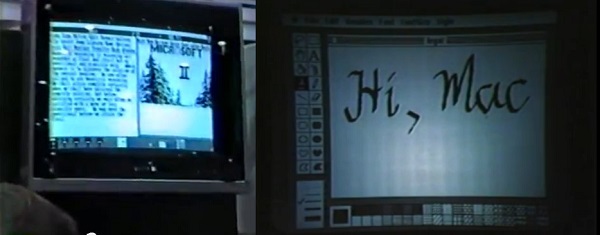
The power, stability, and ease-of-use of personal computing devices advanced so quickly over the past 30 years that it's often difficult to remember how far they've actually come.
Apple celebrated its 30th anniversary with a video and timeline that broke the history of personal computing into eras with typically modest and understated titles, including "The computer that changed everything," "Making the world smaller," "Unleashing every student's potential," and "Creating the future." Meanwhile, a couple of telling videos about the early history of Apple have just resurfaced, courtesy of former PCworld editor-in-chief and current
Time magazine columnist Harry McCraken. The first is a video of the first public demonstration of the Macintosh, at a meeting of Apple shareholders at the Flint Center at De Anza College near Cupertino, Calif. on Jan. 24, 1984. In it, an astonishingly boyish Steve Jobs rolls out not only the
first public demonstration of the Mac user interface, but also introduces many of the tropes and images that helped define the way both Apple and the Mac faithful would view the technology evolution over the following 30 years, including Jobs' own grandiose showmanship, his description of the Mac as "insanely great," and a xenophobic fear of a future defined by computer makers other than Apple. In an even earlier video, from an Apple sales meeting in Hawaii in the fall of 1983, Jobs introduces the
Ridley Scott-directed "1984" which did as much to cement the image of Apple as leader of the Rebel Alliance as anything else Apple or Jobs ever did, despite having aired only once on TV, during the 1984 Super Bowl.
McCracken also published a demo that's at least as important (but far less well documented or remembered) showing the
very first version of Windows being demonstrated at the Microsoft booth on the floor of the 1983 edition of the COMDEX trade show Nov. 28-Dec. 2, 1983 in Las Vegas. That edition announced Nov. 10, 1983, but not shipped until November 1985, was "shockingly crude," McCracken wrote, but does demonstrate that Apple wasn't the only company chasing the goal of making tons of money and dominating the future using graphical front ends. Both Jobs and Apple fans frequently accused Microsoft Corp. of stealing the whole idea of a window-based GUI from Apple – accusations largely based on apocryphal versions of a story about Jobs' 1979 visit to the Xerox PARC research lab, which a Stanford University history of the evolution as
"the closest thing in the history of computing to a Prometheus myth." Probably much closer to the truth is a scene describing a confrontation between Jobs and Microsoft founder Bill Gates,
described in Walter Isaacson's 2011 bio Steve Jobs:
"Their meeting was in Jobs's conference room, where Gates found himself surrounded by ten Apple employees who were eager to watch their boss assail him. Jobs didn't disappoint his troops. 'You're ripping us off!' he shouted. "I trusted you, and now you're stealing from us!' Gates just sat there coolly, looking Steve in the eye, before hurling back, in his squeaky voice, what became a classic zinger. 'Well, Steve, I think there's more than one way of looking at it. I think it's more like we both had this rich neighbor named Xerox and I broke into his house to steal the TV set and found out that you had already stolen it.'"
The COMDEX video, as McCracken also points out, exists due only to the
prescient meta-cognition of Dan Bricklin – still among the most unassuming of the real pioneers of the time – who lugged a giant 1983-era video camera to what he considered significant events to show colleagues at his company Software Arts. The killer app Bricklin co-wrote was VisiCalc, the first commercially successful spreadsheet, which gave non-geeks a reason to use computers for the first time and, arguably, gave the PC revolution more of a push-start than any of the operating systems that became available later, no matter from whom their best features were stolen. "These are provided for historical purposes. They are not for commercial use without permission, All Rights Reserved, etc.," Bricklin wrote. "I think that some people will find them of interest and they should be part of the record available to historians and students."
Image: Dan Bricklin/Apple Computer, Inc.
 The power, stability, and ease-of-use of personal computing devices advanced so quickly over the past 30 years that it's often difficult to remember how far they've actually come. Apple celebrated its 30th anniversary with a video and timeline that broke the history of personal computing into eras with typically modest and understated titles, including "The computer that changed everything," "Making the world smaller," "Unleashing every student's potential," and "Creating the future." Meanwhile, a couple of telling videos about the early history of Apple have just resurfaced, courtesy of former PCworld editor-in-chief and current Time magazine columnist Harry McCraken. The first is a video of the first public demonstration of the Macintosh, at a meeting of Apple shareholders at the Flint Center at De Anza College near Cupertino, Calif. on Jan. 24, 1984. In it, an astonishingly boyish Steve Jobs rolls out not only the first public demonstration of the Mac user interface, but also introduces many of the tropes and images that helped define the way both Apple and the Mac faithful would view the technology evolution over the following 30 years, including Jobs' own grandiose showmanship, his description of the Mac as "insanely great," and a xenophobic fear of a future defined by computer makers other than Apple. In an even earlier video, from an Apple sales meeting in Hawaii in the fall of 1983, Jobs introduces the Ridley Scott-directed "1984" which did as much to cement the image of Apple as leader of the Rebel Alliance as anything else Apple or Jobs ever did, despite having aired only once on TV, during the 1984 Super Bowl. McCracken also published a demo that's at least as important (but far less well documented or remembered) showing the very first version of Windows being demonstrated at the Microsoft booth on the floor of the 1983 edition of the COMDEX trade show Nov. 28-Dec. 2, 1983 in Las Vegas. That edition announced Nov. 10, 1983, but not shipped until November 1985, was "shockingly crude," McCracken wrote, but does demonstrate that Apple wasn't the only company chasing the goal of making tons of money and dominating the future using graphical front ends. Both Jobs and Apple fans frequently accused Microsoft Corp. of stealing the whole idea of a window-based GUI from Apple – accusations largely based on apocryphal versions of a story about Jobs' 1979 visit to the Xerox PARC research lab, which a Stanford University history of the evolution as "the closest thing in the history of computing to a Prometheus myth." Probably much closer to the truth is a scene describing a confrontation between Jobs and Microsoft founder Bill Gates, described in Walter Isaacson's 2011 bio Steve Jobs:
The power, stability, and ease-of-use of personal computing devices advanced so quickly over the past 30 years that it's often difficult to remember how far they've actually come. Apple celebrated its 30th anniversary with a video and timeline that broke the history of personal computing into eras with typically modest and understated titles, including "The computer that changed everything," "Making the world smaller," "Unleashing every student's potential," and "Creating the future." Meanwhile, a couple of telling videos about the early history of Apple have just resurfaced, courtesy of former PCworld editor-in-chief and current Time magazine columnist Harry McCraken. The first is a video of the first public demonstration of the Macintosh, at a meeting of Apple shareholders at the Flint Center at De Anza College near Cupertino, Calif. on Jan. 24, 1984. In it, an astonishingly boyish Steve Jobs rolls out not only the first public demonstration of the Mac user interface, but also introduces many of the tropes and images that helped define the way both Apple and the Mac faithful would view the technology evolution over the following 30 years, including Jobs' own grandiose showmanship, his description of the Mac as "insanely great," and a xenophobic fear of a future defined by computer makers other than Apple. In an even earlier video, from an Apple sales meeting in Hawaii in the fall of 1983, Jobs introduces the Ridley Scott-directed "1984" which did as much to cement the image of Apple as leader of the Rebel Alliance as anything else Apple or Jobs ever did, despite having aired only once on TV, during the 1984 Super Bowl. McCracken also published a demo that's at least as important (but far less well documented or remembered) showing the very first version of Windows being demonstrated at the Microsoft booth on the floor of the 1983 edition of the COMDEX trade show Nov. 28-Dec. 2, 1983 in Las Vegas. That edition announced Nov. 10, 1983, but not shipped until November 1985, was "shockingly crude," McCracken wrote, but does demonstrate that Apple wasn't the only company chasing the goal of making tons of money and dominating the future using graphical front ends. Both Jobs and Apple fans frequently accused Microsoft Corp. of stealing the whole idea of a window-based GUI from Apple – accusations largely based on apocryphal versions of a story about Jobs' 1979 visit to the Xerox PARC research lab, which a Stanford University history of the evolution as "the closest thing in the history of computing to a Prometheus myth." Probably much closer to the truth is a scene describing a confrontation between Jobs and Microsoft founder Bill Gates, described in Walter Isaacson's 2011 bio Steve Jobs:

